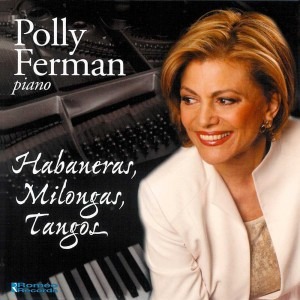
artist: — Polly Ferman
title: — Habaneras, Milongas, Tangos
date: — September 1994, CD released in 2000
sample: — Piazzolla: Adiós Nonino (excerpt)
Music by Gottschalk, Cervantes, Chabrier, Albéniz, Nazareth, Milhaud, Satie, Stravinsky, Weill, Penaforte, Ginastera, Saens, Piazzolla, Lagarmilla.
“Ferman’s pianism is very aristocratic, and she makes the listener believe that Chabrier’s habanera is a real apotheosis of a dance form rating with Schubert, Chopin and Brahms… Her rhythms sway and insinuate and her touch is wonderful, perfectly suited to soft nuanced playing… Polly Ferman’s pianism is superb and of a kind no longer common.”
The American Record Guide
Liner Notes:
Habaneras, Milongas, Tangos
There is no consensus about the origins of the word tango. Some studies suggest that it is derived from the name of the African Yoruba god of thunder, Shango. However, most specialists agree that the tango is a descendant from the Cuban habanera, a dance that became very popular in the salons of the second half of the 19th century. From it, came the Andalusian tango, the Brazilian maxixe and tango, as well as the Argentine milonga and tango.
The American Louis Moreau Gottschalk (1829-1869) was the first international musician to incorporate the habanera rhythm into his own music. Gottschalk visited Cuba several times and was highly successful there. One of his Cuban pupils was Ignácio Cervantes (1847-1905), who later worked with Alkan and Marmontel in Paris. Cervantes wrote “Cuban dances” that are beautiful, jewel-like, concise structures.
Chabrier, Bizet, Debussy, and Ravel wrote habaneras. Emanuel Chabrier (1841-1894) wrote his “Habanera” in 1885 as a souvenir from his voyage to Spain. Isaac Albéniz (1860-1909), who had a tempestuous early life and ran away from home, embarked as a stowaway for South America. Between 1872 and 1873, he survived in Argentina, Uruguay, Brazil, Cuba and Puerto Rico, ending his trip in the United States. It is interesting to note the motivic similarity between Chabrier’s “Habanera” and Albéniz’s “Tango.”
In Brazil, Ernesto Nazareth (1863-1934) wrote a different kind of tango, usually jocular, sometimes sad, closer to the Cuban habanera. Nazareth’s music was seminal to the development of Villa-Lobos and Darius Milhaud (1892-1974), whose “Tango des Fratellini,” extracted from “Boeuf sur le Toit,” emulates the Brazilian style and mood.
However, it was the Argentine tango that conquered Paris, in the beginnings of the 20th century and became internationally known. Composers took notice of the dance’s success and began composing tangos in their own styles.
As expected, the “Perpetual Tango” by Erik Satie (1866-1925) is deliberately modest and inconsequential. Igor Stravinsky (1882-1971) wrote his first “Tango” as a movement to “L’Histoire du Soldat” in 1918. He also wrote two piano tangos. The earlier, titled originally “Pesante,” as the last movement from the “Five Fingers” (1921), was named “Tempo di Tango” when he orchestrated the material as “Eight Instrumental Miniature for 15 Players” (1962). These brief compositions by Satie and Stravinsky recall the concise structures of Cervantes and, although unintended, pair off beautifully. Stravinsky’s later, more substantial “Tango” in the Argentine style, was the first piece he composed in the United States in 1940. He orchestrated it in 1953. Kurt Weill (1900-1950) probably wrote his tango habanera “Youkali,” in 1935, before moving to New York. “Youkali” was published as a song, but since the vocal line is virtually repeated in the piano part, it can be safely performed as a piano piece.
The only work commissioned especially for the present recording project is by Raimundo Penaforte (1961-), a young Brazilian composer with a rapidly growing international reputation. Penaforte’s “Ephigennia” (1993) is a humorous, irreverent tango.
Many consider the milonga the most characteristic Argentine dance. Alberto Ginastera (1916-1983) did not write tangos, but wrote a “Milonga.”
Like the habanera, the milonga is in duple meter (2/4) whereas the tango is usually in 4/4.
The Argentine tango flourished in the Río de la Plata region of Argentina and Uruguay. The best known tangos were written by composers of both countries. Apart from the popular tango, there are more “cultivated” compositions of the kind, like those of Uruguayan Roberto Lagarmilla (1913-1992), and the Argentinians Pedro Saenz (1915-1995), and Astor Piazzolla (1921-1992). Piazzolla’s works, innovative as they are, conform to the description of Jorge Luis Borges, who saw the tango as “a vast expression of the incoherent comédie humaine of the life of Buenos Aires.”
©William Daghlian
New York, 1994